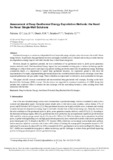JavaScript is disabled for your browser. Some features of this site may not work without it.
| dc.contributor.author | Falcone, Gioia | |
| dc.contributor.author | Liu, Xiaolei | |
| dc.contributor.author | Radido Okech, Roy | |
| dc.contributor.author | Seyidov, Ferid | |
| dc.contributor.author | Teodoriu, Catalin | |
| dc.date.accessioned | 2018-10-05T08:35:27Z | |
| dc.date.available | 2018-10-05T08:35:27Z | |
| dc.date.issued | 2018-06-28 | |
| dc.identifier.citation | Gioia Falcone, Xiaolei Liu, Roy Radido Okech, et al., Assessment of deep geothermal energy exploitation methods: The need for novel single-well solutions. Energy, Volume 160, October, 2018, Pages 54-63 | en_UK |
| dc.identifier.issn | 0360-5442 | |
| dc.identifier.uri | https://doi.org/10.1016/j.energy.2018.06.144 | |
| dc.identifier.uri | http://dspace.lib.cranfield.ac.uk/handle/1826/13507 | |
| dc.description.abstract | Geothermal energy is a constant and independent form of renewable energy and plays a key role towards the world's future energy balance. In particular, deep geothermal resources are largely available across continents and can help countries become less dependent on energy imports and build a broader base in their future energy mix. However, despite its significant potential, the total contribution of the geothermal sector to global power generation remains relatively small. The International Energy Agency has recommended devising plans to address technology-specific challenges to achieve faster growth and improving policies tackling pre-development risks for geothermal energy. Reaching considerable depths is a requirement to exploit deep geothermal resources, but experience gained to date from the implementation of complex, engineered deep geothermal projects has unveiled technical and economic challenges, lower-than-expected performance and poor public image. There is therefore an urgent need for alternative, more sustainable well designs. This paper critically assesses conventional and unconventional deep geothermal well concepts, focusing on the basic Borehole Heat Exchanger (BHE) concept. The discussions are supported by numerical simulations of a BHE design that includes heat conductive fillers to enhance the heat exchange with the surrounding formation, while avoiding direct fluid interaction with the latter. | en_UK |
| dc.language.iso | en | en_UK |
| dc.publisher | Elsevier | en_UK |
| dc.rights | Attribution-NonCommercial-NoDerivatives 4.0 International | * |
| dc.rights.uri | http://creativecommons.org/licenses/by-nc-nd/4.0/ | * |
| dc.subject | Deep geothermal energy | en_UK |
| dc.subject | Geothermal potential | en_UK |
| dc.subject | Deep borehole heat exchangers | en_UK |
| dc.title | Assessment of deep geothermal energy exploitation methods: The need for novel single-well solutions | en_UK |
| dc.type | Article | en_UK |
Files in this item
The following license files are associated with this item:
This item appears in the following Collection(s)
-
Staff publications (SWEE) [2827]

